Celtic - Classical antiquity - Fotogalerie - Sold antiquities
Archive of sold antiquities
All artefacts sold in our gallery are fully documented in our online archive and database. Being a specialist ancient art dealer, preserving also the more recent history of each and every piece sold in our shop is at our heart. That is particularly useful for artefacts that changed owners in the meantime. Information that may have been lost in the process can be easily restored from our archives. Please do not hesitate to contact us if you need further information about ancient items that have been sold in our gallery. We can help you with reconstructing the history of ownership for those items. All information about our customers will be kept confidential, of course.-
 Disc brooch from Roman Britain
Disc brooch from Roman BritainBrooch with a Romano-Celtic sunburst design. Circa 2nd century. A find from Roman Britain
Price: on request Roman Celtic seal box
Roman Celtic seal boxLozenge shaped body with lid in Celtic design. A piece from the 1st or 2nd century, found near the Celtic settlement and later Roman town of Lindum. Published in a standard work by Richard Hattatt.
Price: on request Celtic coin - Iceni tribe
Celtic coin - Iceni tribeEast Anglia mint, reported to have been found in Stonea Grange, Cambridgeshire.
Price: on request Celtic coin - Iceni tribe
Celtic coin - Iceni tribeEast Anglia mint, reported to have been found in Stonea Grange, Cambridgeshire.
Price: on request Trumpet brooch with Celtic decorations
Trumpet brooch with Celtic decorationsUnusual and rare variant of high importance, published several times. Beautiful silver inlays on the bow showing tendrils in Celtic style. From the 1st century.
Price: on request Disc brooch from Roman Britain
Disc brooch from Roman BritainNicely enameled brooch with a Romano-Celtic sunburst design. From the 2nd century AD. Published in two stardard works on ancient brooches by Richard Hattatt.
Price: on request Dolphin brooch from Roman Britain
Dolphin brooch from Roman BritainThe so-called dolphin brooch is very British. This specimen was probably made by the Celtic Corieltauvi tribe, shortly after the arrival of the Romans in the middle of the 1st century. Published in two works by Richard Hattatt.
Price: on request Celtic penannular brooch
Celtic penannular broochPossibly made by the Celtic Durotriges tribe under Roman rule in Britain. The piece is published in two books by Richard Hattatt.
Price: on request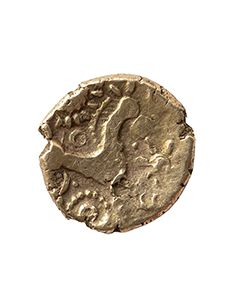 Extremely rare Celtic gold stater of Regni tribe
Extremely rare Celtic gold stater of Regni tribeFound 2015 in Winterbourne, West Berkshire, UK. Registered with the Portable Antiquities Scheme, reference BERK-1FC826.
Price: on request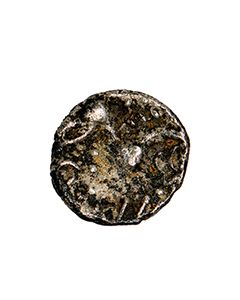 Celtic coin - Iceni tribe
Celtic coin - Iceni tribeEast Anglia mint, reported to have been found in Stonea Grange, Cambridgeshire.
Price: on request Celtic coin - Iceni tribe
Celtic coin - Iceni tribeEast Anglia mint, reported to have been found in Stonea Grange, Cambridgeshire.
Price: on request Celtic coin - Iceni tribe
Celtic coin - Iceni tribeEast Anglia mint, reported to have been found in Stonea Grange, Cambridgeshire.
Price: on request Celtic coin - Iceni tribe
Celtic coin - Iceni tribeEast Anglia mint, reported to have been found in Stonea Grange, Cambridgeshire.
Price: on request Perfectly preserved Celtic coin - Iceni tribe
Perfectly preserved Celtic coin - Iceni tribeEast Anglia mint, reported to have been found in Stonea Grange, Cambridgeshire.
Price: on request Ancient brooch of a fabulous creature
Ancient brooch of a fabulous creatureRare Hippocampus brooch with elaborate inlays of multi-coloured glass paste and metal. Great example of the brooch manufacturing of Roman Gaul during the mid 1st cent. AD.
Price: on request Roman plate brooch with colourful enamel
Roman plate brooch with colourful enamelRare fibula type from Roman Britain. The fully intact multicoloured enamel makes this piece worthy of being a museum exhibit. 2nd cent. AD.
Price: on request Elaborate Roman plate brooch
Elaborate Roman plate broochTen pointed star form with leaf pattern and decorative buttons. A product of Gaul or Britain dating to the 1st century.
Price: on request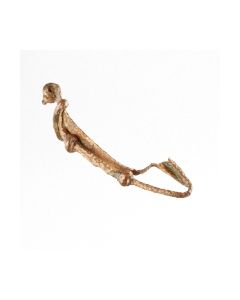 Celtic fibula from the famous Hattatt collection
Celtic fibula from the famous Hattatt collectionFibula from the La Tène II period. Found in Celtic Carnuntum. The piece is published in the standard work "Iron Age and Roman Brooches".
Price: on request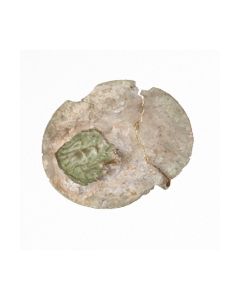 Ancient fibula from the Hattatt collection
Ancient fibula from the Hattatt collectionAncient fibula of the rare adlocutio type. Repoussé work of a scene from a Roman sestertius of Hadrian in celtic style. Find from Dorset in Roman Britain. Published in Hattatts famous book series on ancient fibulae.
Price: on request Published Roman fibula with celtic design
Published Roman fibula with celtic designAncient fibula from the Roman province of Britain. The design can be attributed to the celtic tribe of the Trinovantes or Iceni. From the famous Hattatt collection. Published twice.
Price: on request Celtic gold stater from the age of Caesar's Gallic Wars
Celtic gold stater from the age of Caesar's Gallic WarsExtremely fine Ambiani gold stater, 60-25 BC. AV: Plain bulge (remnants of the head of Apollo); RV: Abstract horse right, below and above dots and sickles.
Price: on request Zwei römische Pfeilspitzen
Zwei römische PfeilspitzenLanggezogene Pfeilspitzen aus Eisen/Bronze, perfekte Erhaltung. Fundort: Niedergermanien.
Price: on request Römische Silberfibel
Römische SilberfibelMassive Fibel aus Silber. Fundort England, aus alter britischer Sammlung. Museumswürdiges Exemplar.
Price: on request Römische Nadel aus Bein
Römische Nadel aus BeinNadel oder Haarnadel aus Bein. Kunstvoll gearbeiteter Kopf. Fundort: White Noteley, Essex, England.
Price: on request Keltische Fibel aus Silber
Keltische Fibel aus SilberSeltener Typ mit Dekor, 1. Jh. v. Chr. - 1. Jh. n. Chr. Museales Stück mit schöner Tönung.
Price: on request Keltische Münze, Stamm der Senonen
Keltische Münze, Stamm der SenonenSeltene Münze des Senonenstammes. Stilisierter Kopf mit Stachelhaaren n.r. Potin, Durchmesser ca. 16mm, Gewicht 3,86 Gramm.
Price: on request Gruppe von 3 Terra Sigillata-Scherben
Gruppe von 3 Terra Sigillata-ScherbenRömisch, 1. bis 3. Jh. n.Chr., Provinzen Germania, Scherben von Keramik mit rotem Glanzton-Überzug (Engobe). Bemerkenswert sind die erhaltenen Dekorationselemente.
Price: on request Terra Sigillata Boden mit Stempel FELIXSEV
Terra Sigillata Boden mit Stempel FELIXSEVSüdgallische TS aus der Werkstatt des Felix und Severus aus La Graufesenque. 40 - 80 n. Chr. Ein für Trier seltener Stempel
Price: on request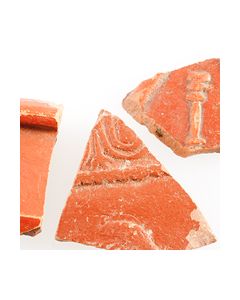 Gruppe von 3 Terra Sigillata-Fragmenten
Gruppe von 3 Terra Sigillata-FragmentenRömisch, 1. bis 3. Jh. n.Chr., Provinzen Germania, Scherben von Keramik mit rotem Glanzton-Überzug (Engobe). Bemerkenswert sind die erhaltenen Dekorationselemente.
Price: on request Gruppe von 3 Terra Sigillata-Scherben
Gruppe von 3 Terra Sigillata-ScherbenRömisch, 1. bis 3. Jh. n.Chr., Provinzen Germania, Scherben von Keramik mit rotem Glanzton-Überzug (Engobe). Bemerkenswert sind die erhaltenen Dekorationselemente.
Price: on request Terra Sigillata Boden mit Stempel VITRIOFE
Terra Sigillata Boden mit Stempel VITRIOFEAus der Werkstatt des Vitrio, Ostgallien, möglicherweise Trier. Sehr tiefer Stempel, museumswürdiger Zustand.
Price: on request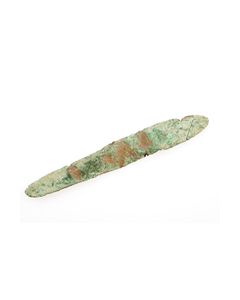 Keltisches Sägeblatt
Keltisches SägeblattLängliche Klinge aus Bronze, wahrscheinlich Sägeblatt. Rauhe Oberfläche, sehr guter Erhaltungszustand.
Price: on request Keltisches Messer aus Bronze
Keltisches Messer aus BronzeGlatte, gereinigte Oberfläche, sehr schöne, gleichmäßige Patina. Exzellenter Erhaltungszustand.
Price: on request Keltische Münze, Stamm der Senonen
Keltische Münze, Stamm der SenonenSeltene Münze des Senonenstammes. Stilisierter Kopf mit Stachelhaaren n.r. Potin, Durchmesser ca. 19mm, Gewicht 3,34 Gramm.
Price: on request Römischer Präsentierteller aus England
Römischer Präsentierteller aus EnglandKonisch gestalteter Standfuß, kunstvoll gestaltet. Leicht konischer Körper, hohe, gerade Lippe. Fundort: Colchester in Essex, England.
Price: on request Gruppe von 3 mittelgroßen Terra Sigillata-Scherben
Gruppe von 3 mittelgroßen Terra Sigillata-ScherbenRömisch, 1. bis 3. Jh. n.Chr., Provinzen Germania, Scherben von Keramik mit rotem Glanzton-Überzug (Engobe). Bemerkenswert sind die erhaltenen Dekorationselemente.
Price: on request

